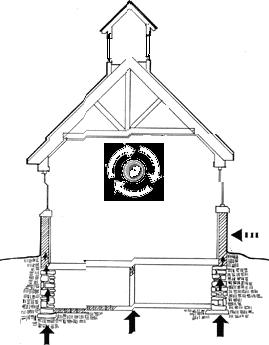 |
|
|
|
The Invaders have a science! |
 Moisture
as home-wrecker.
Moisture
as home-wrecker. Most moisture problems are the result of rain or snow, high humidity, or high water tables. But some of the most troublesome moisture damage in older houses can be caused inside the house by leaky plumbing, heaters and air conditioners, as well simply cooking and doing laundry. Taken as a whole, the wet invaders can control your house unless you manage them!
For example, water as vapor--warm moist air--moves from a high pressure area to a lower pressure area where the air is cooler and drier. Liquid water moves as a result of differences in hydrostatic pressure or wind pressure. How fast moisture moves depends on how permeable the building materials are and how quickly water is absorbed. More formal terminology may be used to describe moisture movement and how it invades a house: lateral penetration (from the outside of the house in), capillary action (wicking up from the ground), and vapor diffusion (condensation within the house's interior). The subject is infinitely complex and, thus, one of continuing scientific study. For purposes of this mini-web class, however, we'll keep the terms simple and hit the main points. Identifying the problem and discovering its source or sources (from the outside, the ground, or within) usually involves the human senses of sight, smell, hearing, touch, and taste! Here are some of the more common signs of visible--as well as hidden--moisture damage:
|
 It's
good to understand the forces that move air and moisture through
a building so you can better identify and correct a problem.
The drawing shows how moisture can invade "inward" from the
exterior; "upward" from the ground; and be generated from "within"
the interior. All have damaging effects.
It's
good to understand the forces that move air and moisture through
a building so you can better identify and correct a problem.
The drawing shows how moisture can invade "inward" from the
exterior; "upward" from the ground; and be generated from "within"
the interior. All have damaging effects.